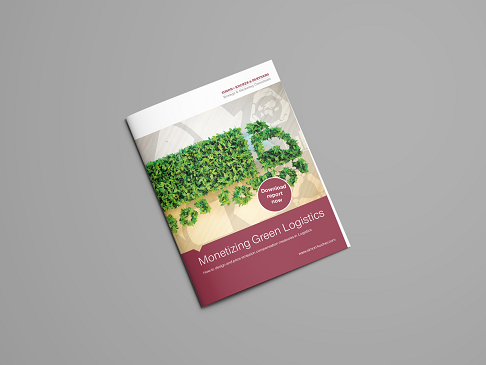When it comes to sustainability, the logistics sector has a lot of catching up to do. Only few companies commit to long-term sustainability investments – but more and more customers will be expecting exactly this in the future. To fulfill their requests for more sustainable products, logistics services providers have to start developing them now.
Sustainability is an important topic for consumers and companies all over the world. Increasingly, the latter are also demanding more sustainable business practices of their service providers, as we explained in the first part of our blog series. It is highly worthwhile for logistics services providers to aim at fulfilling this growing need – but first, they need the right product! How can they incorporate green logistics into their product offering? What kind of accompanying marketing strategy is needed to communicate the new offer clearly and visibly to customers in order to trigger a higher willingness to pay (extra) for it? Let’s find out!
Customer preferences undecided
The first important step is to find out what logistics companies’ customers actually want in terms of a more sustainable offering. In our recently published Simon-Kucher Green Logistics B2B study, where we surveyed over 400 companies across the globe that use logistics service providers, we determined that shippers are pretty undecided on the appropriate means to achieve sustainability. 66 percent of them indicated that they strive for “truly” sustainable solutions by avoiding emissions. 54 percent want to achieve sustainability by indirect solutions, e.g., through compensating emitted emissions. Greenwashing (for instance purchases of CO2 certificates) are considered by 35 percent of customers. And the majority would choose more than one instrument and not commit to a specific range of measures.
Lack of know-how in terms of sustainable logistics measures
When it comes to choosing their logistics supplier, however, the figures look a bit different as there isn’t such a clear difference between “true” and indirect sustainable solutions.

As you can see, even “greenwashing” is more acceptable in this scenario. Emission avoidance/reduction still comes in first, but it is only slightly ahead of carbon-offsetting and CO2 certification purchases, which both rank the same.
What does this mean for logistics companies? There is still considerable room for improvement in terms of developing green service offerings and clearly communicating their differences. Logistics customers are familiar with their own industries and obviously are proficient at judging what makes sense in terms of sustainability for them. For their logistics service providers, they lack this know-how and therefore rely on their vendors to make these decisions and explain it to them.
Status quo of green product design: compensation instead of avoidance
If customer preferences do not give a clear indication towards what a sustainable logistics product design should look like, maybe it’s worth looking at some existing examples in the industry? What are they doing, and does it actually work? Unfortunately – due to the plethora of options – there is no silver bullet out there (yet) when it comes to a green product design. Logistics players experiment with a variety of different sustainable service offerings. For example:
- Lufthansa Cargo lets its customers choose how to reduce the CO2 footprint of their shipments: with sustainable aviation fuel or by compensating it in other sectors.
- Air Canada enables its customers to offset their flights directly and, in addition, let’s them choose between different offset products and projects. Furthermore, customers can opt-out offsetting emissions at high altitudes.
- GLS charges customers a 3.5 percent climate surcharge to offset carbon emissions created by them.
- The Quantas group offers customers to voluntarily offset carbon emissions for their flights, and additionally promising to match each dollar spend, effectively doubling the investment through subsidies.
Looking at these examples, it becomes obvious that compensation solutions for emissions are very common. They still seem to be more frequent than direct solutions to avoid emissions.
C-level involvement vital in designing new solutions
A takeaway for logistics companies could therefore very well be that designing your sustainable product to be all about compensation is a safe and viable choice. However, in our opinion, this strategy also lacks ambition and could backfire in the future. Either way, designing a sustainable logistics solution is far from being trivial and requires C-level involvement to determine the right dimensions of the offer. If you start from square one, you need to consider many perspectives and search for answers to a lot of questions – without C-level input, the outcome won’t be as valuable.

The basis of good product design: customer segmentation
After deciding on the different aspects of a sustainable product offering as depicted above, you need to make sure to market it appropriately. This requires a clear value proposition which…
- … reveals the added value of your new, sustainable product from your customers’ perspectives
- … is differentiated based on customer segment needs (while the differentiating factors are obvious to the different groups)
To achieve this, logistics companies need a detailed understanding of their respective customer bases. This is the initial step of designing a sustainable logistics product. Afterwards you can aim at fulfilling the needs of these different customer segments adequately. Finally, the optimal solution/offer is also dependent on the willingness-to-pay of each customer (segment). How high the customers’ willingness-to-pay is for a sustainable logistics product and how it differs between segments will be addressed in the following articles of our blog series.

Monetizing Green Logistics
How to design and price emission compensation measures in Logistics








